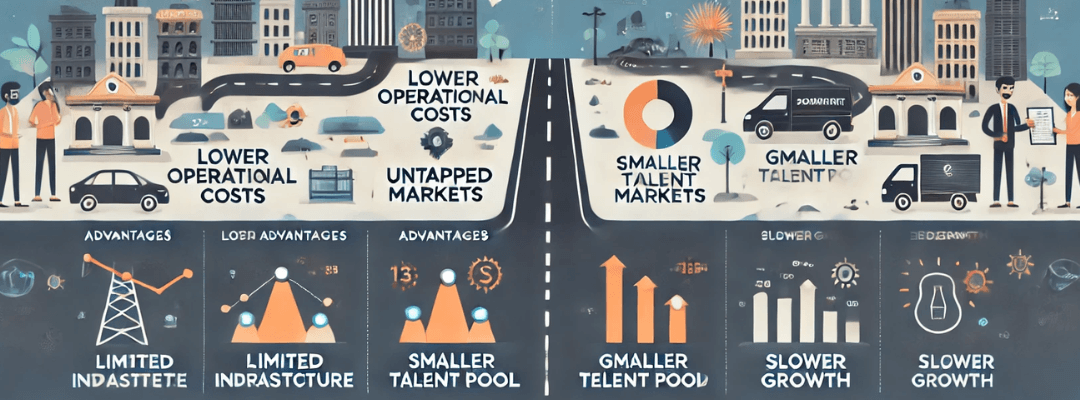Starting a business in Tier 3 cities in India offers both advantages and disadvantages. These cities, typically smaller than Tier 1 and Tier 2 cities, are emerging as potential hubs for entrepreneurship. Here’s a breakdown of the pros and cons:
Advantages of Starting a Business in Tier 3 Cities
- Lower Operating Costs
- Affordable Real Estate: The cost of land, office space, and retail outlets is significantly lower in Tier 3 cities, which reduces the financial burden of starting and operating a business.
- Lower Wages and Overheads: Employee salaries, utilities, and other operating expenses tend to be lower, which can improve profit margins and reduce initial capital requirements.
- Untapped Market Potential
- Less Competition: Compared to Tier 1 and Tier 2 cities, there is often less competition in Tier 3 cities, especially in specific industries. This offers businesses a chance to enter the market early and build a strong customer base.
- Growing Consumer Base: As Tier 3 cities develop, the purchasing power of their residents is increasing. There is rising demand for goods and services, especially in sectors like retail, healthcare, education, and technology.
- Government Incentives
- Subsidies and Support: Governments often provide incentives such as tax breaks, subsidies, and relaxed regulations to encourage businesses to set up in Tier 3 cities. This can reduce the overall cost of doing business and support long-term growth.
- Infrastructure Development Plans: Many Tier 3 cities are part of government infrastructure and development initiatives, which provide opportunities to capitalize on future growth.
- Community Support
- Brand Loyalty: Residents in Tier 3 cities often support local businesses, creating strong customer loyalty. The relatively smaller population allows for closer customer relationships and personalized service.
- Networking Opportunities: Building local partnerships and connections with suppliers, customers, and even government officials is often easier in Tier 3 cities, which can help streamline business operations.
- Room for Innovation
- Experimentation: With less market saturation and competition, businesses can experiment with new products, services, or models tailored to local needs. This flexibility can lead to niche market dominance.
- First-Mover Advantage: In many industries, entering a Tier 3 city gives businesses the chance to establish a stronghold before competitors arrive.
- Better Quality of Life
- Lower Cost of Living: Tier 3 cities offer a more affordable lifestyle compared to larger cities, which can attract talent seeking a good work-life balance and a lower cost of living.
- Less Stressful Environment: These cities often have less traffic, congestion, and pollution, creating a healthier work environment for employees.
Disadvantages of Starting a Business in Tier 3 Cities
- Limited Skilled Workforce
- Talent Shortage: Tier 3 cities may lack a skilled workforce, especially for industries that require specialized knowledge (e.g., IT, engineering, finance). Businesses may struggle to find qualified employees locally.
- Brain Drain: Many skilled professionals from Tier 3 cities move to Tier 1 or Tier 2 cities for better job opportunities and higher salaries, leading to a smaller talent pool.
- Lower Purchasing Power
- Smaller Consumer Base: While purchasing power is growing, the average income levels in Tier 3 cities are often lower than in larger cities, which may limit demand for premium products and services.
- Price Sensitivity: Consumers in Tier 3 cities may be more price-conscious, making it harder for businesses to sell higher-end products or services without careful pricing strategies.
- Underdeveloped Infrastructure
- Logistics Challenges: Tier 3 cities often lack the robust infrastructure available in larger cities, such as advanced transportation systems, reliable internet, or well-developed supply chains. This can lead to delays in delivery, higher transportation costs, and logistical inefficiencies.
- Limited Public Services: Access to essential public services, such as healthcare, education, and banking, might be underdeveloped, affecting overall business operations and employee well-being.
- Limited Market Size
- Smaller Demand: The total market size in Tier 3 cities is often smaller compared to Tier 1 and 2 cities, which could limit the scalability of the business.
- Slower Economic Growth: Although these cities are developing, economic growth can be slower, which may affect the overall pace of business expansion.
- Brand and Product Awareness
- Lower Brand Recognition: Many international and premium brands may have limited or no presence in Tier 3 cities, making it harder to build immediate trust and demand for certain products or services.
- Marketing Challenges: Businesses may need to invest more in awareness campaigns, educating customers about the benefits of their products or services.
- Slower Technology Adoption
- Lagging Digital Infrastructure: Although internet and digital penetration is increasing, Tier 3 cities may still lag behind in terms of technology adoption, which can affect sectors such as e-commerce, fintech, or online services.
- Limited Access to Advanced Technologies: Businesses that rely on cutting-edge technology or require high-speed internet may face challenges due to inconsistent service quality or lack of infrastructure.
- Cultural Barriers
- Local Preferences: Tier 3 cities may have strong local cultures and traditions, which can sometimes make it difficult for businesses from outside the region to integrate or appeal to the local population.
- Adaptation of Products: Products or services may need to be adapted to fit local preferences, which could require additional investment and research.

